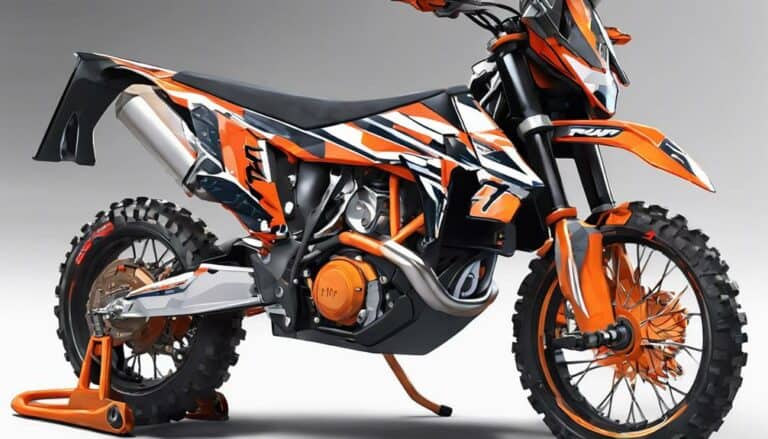Curious about when KTM dirt bikes made the switch to fuel injection?
The timeline of this technological advancement might surprise you, shedding light on KTM's dedication to enhancing performance and meeting modern standards.
Stay tuned to uncover the pivotal moment that reshaped the landscape of KTM's off-road machines and what it means for the future of dirt biking.
Key Takeaways
- KTM introduced fuel injection in 2012 with lateral injectors.
- Transfer Port Injection (TPI) in 2018 revolutionized emissions compliance.
- Fuel injection eliminated re-jetting needs and improved rideability.
- Advancements in fuel injection technology enhanced power delivery and efficiency.
Evolution of KTM's Fuel Injection Technology
KTM's Fuel Injection Technology has undergone a notable evolution since its inception in 2012, marked by the introduction of lateral injectors for a direct-injection system. The shift to Transfer Port Injection (TPI) technology in 2018 for KTM's two-stroke engines was essential to meet stricter emissions regulations like Euro4. This technological advancement not only allowed KTM to enhance rideability and power characteristics but also greatly reduce emissions. Challenges faced during this transformation included integrating the new systems into existing bike frames, addressing maintenance concerns, and ensuring injector reliability.
The development of KTM's TPI two-stroke engines aimed to maintain the robust power characteristics of carbureted engines while simultaneously improving overall performance and fuel efficiency. This evolution in KTM's fuel injection technology highlights the brand's commitment to staying at the forefront of innovation in the dirt bike industry. Riders can now enjoy enhanced rideability, improved power delivery, and reduced environmental impact thanks to KTM's continuous advancements in fuel injection systems.
Introduction of Fuel Injection in KTM Dirt Bikes
The introduction of fuel injection technology in KTM dirt bikes revolutionized engine performance and emissions compliance in the off-road motorcycle industry.
In 2012, KTM made a significant leap by incorporating fuel injection into their lineup, starting with the 525 EXC model. This move was pivotal in meeting stringent emissions regulations while simultaneously enhancing overall performance.
Building on this success, in 2017, KTM took another significant step forward with the release of the 300 EXC TPI model, which featured an even more refined fuel injection system. The shift to fuel injection not only eliminated the need for re-jetting but also greatly improved rideability.
This technological advancement marked a milestone in engine technology for KTM dirt bikes, allowing for better efficiency and more precise power delivery, ultimately enhancing the overall riding experience for off-road enthusiasts.
Impact of Fuel Injection on KTM Performance
Embracing fuel injection technology in KTM dirt bikes has fundamentally transformed their performance capabilities. The integration of fuel injection systems and the evolution to Transfer Port Injection (TPI) technology have revolutionized the way KTM bikes perform, enhancing various aspects of the riding experience. Here's how fuel injection has impacted KTM performance:
- Improved Power Characteristics: Fuel injection systems in KTM dirt bikes have optimized fuel and air mixing, leading to more efficient combustion and enhancing power delivery across the rev range.
- Enhanced Rideability: The shift to TPI technology has greatly improved rideability by providing better throttle response, smoother power delivery, and increased tractability in various riding conditions.
- Superior User Experience: Fuel injection not only helped KTM meet stringent Euro4 regulations for emissions control but also elevated the overall user experience by offering consistent performance, eliminating the need for frequent re-jetting, and ensuring a more responsive and enjoyable ride.
Advantages of Fuel Injection in KTM Bikes
Integrating fuel injection technology in KTM bikes has brought about significant advancements in performance and efficiency. The implementation of Transfer Port Injection (TPI) technology in 2018 models marked a pivotal step for KTM in meeting the stringent Euro4 regulations while enhancing rideability and power characteristics.
TPI technology not only optimized fuel delivery but also led to a substantial reduction in emissions, aligning with environmental standards. The shift to TPI two-stroke engines eliminated the hassle of re-jetting under varying conditions, offering riders a seamless experience with consistent performance.
Future of Fuel Injection in KTM Dirt Bikes
Fuel injection technology continues to drive the evolution of KTM dirt bikes towards enhanced performance and efficiency. The future of fuel injection in KTM dirt bikes holds exciting prospects, as the company continues to innovate and push boundaries. Here's what you can expect:
- Advancements in Two-Stroke Technology: KTM's shift to the Transfer Port Injection (TPI) system for two-stroke models has been a game-changer, offering improved rideability, power characteristics, and reduced emissions compared to carbureted engines.
- Commitment to Innovation: KTM's dedication to advancing two-stroke technology signals a promising future with plans to develop more cutting-edge two-stroke bikes. This commitment underscores KTM's position as a leader in motorcycle innovation.
- Racing Success and Competitive Edge: The recent victory of Manuel Lettenbichler in the FIM Hard Enduro World Championship using KTM's two-stroke engines showcases the competitive edge and potential of their technology in the world of racing.
Stay tuned for more groundbreaking developments as KTM continues to revolutionize the dirt bike industry through fuel injection technology.
Conclusion
You've witnessed the evolution of KTM dirt bikes with the introduction of fuel injection in 2017. This groundbreaking technology has revolutionized performance, rideability, and emissions control in models like the 250 EXC TPI and 300 SX.
As KTM continues to push boundaries, the future of fuel injection in their dirt bikes promises even greater advancements and efficiency. Embrace the power of innovation with KTM's fuel-injected machines and ride towards a brighter, cleaner future.

